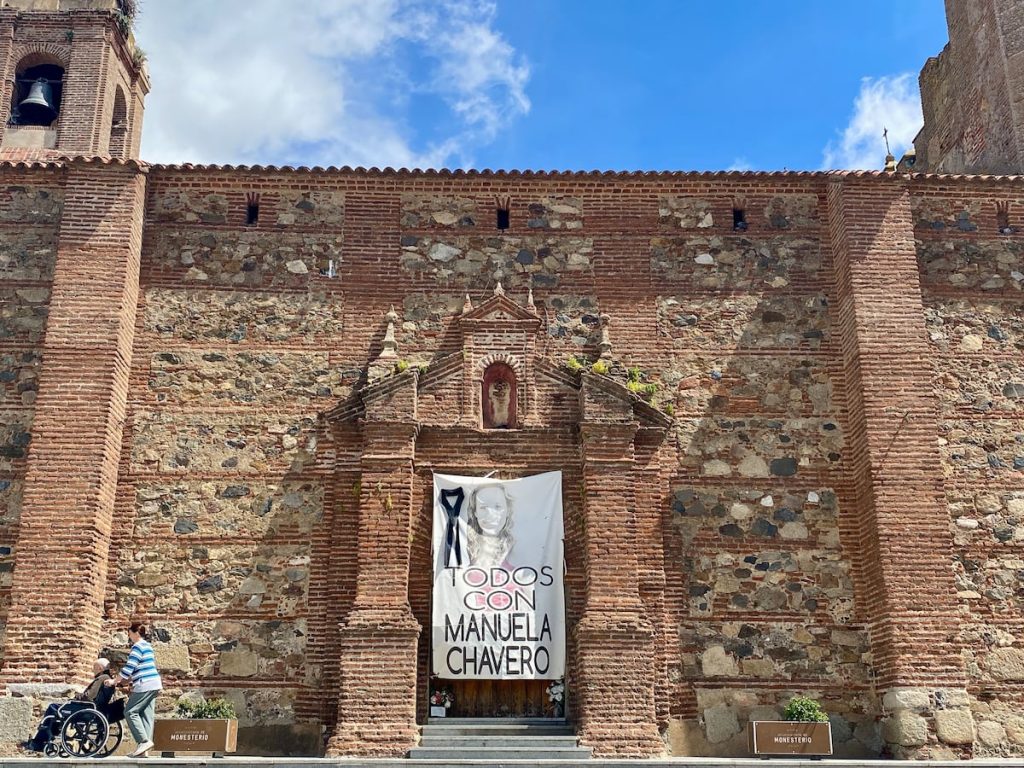Francisco Javier leaves his home in the Extremaduran town of Monesterio with his timid black dog that barks at strangers. His house is located between the homes of Eugenio Delgado, the murderer, and Manuela Chavero, the victim. Two days after realizing that tragedy can strike from within the community, Eugenio is declared guilty of raping, killing, and hiding Manuela’s body on one of his farms outside the town. Monesterio, a town of 4,200 inhabitants known for its ham industry, is deeply affected by the four years of tragedy that followed Manuela’s disappearance. A banner with Manuela’s image hangs on the church wall, surrounded by white and pink flowers.
Manuela Chavero, a 42-year-old woman, had been enjoying her single life and focusing on her family before her disappearance. She lived in a housing development with her children and had a close relationship with her siblings. Despite the efforts of the community to support her family during the four years of uncertainty, the town was engulfed in rumors, suspicion, sadness, and outrage. Manuela’s mother remained at home in mourning, supported by friends who helped with daily tasks. One of Manuela’s sisters fought to keep her sister’s case alive through media appearances and rallies for justice.
The investigation into Manuela’s disappearance affected several neighbors, including her ex-husband and the last man she spoke to on the night she vanished. Rumors and speculation swirled around the close-knit community, leading to suspicion and unease. The case dominated conversations in shops, restaurants, and homes, with posters of Manuela reminding everyone of the tragedy. The emotional toll of the crime on the community is evident in the conversations and reactions of residents who struggle to come to terms with the heinous nature of the crime.
The case against Eugenio was built on the premise that he had no reason to kill Manuela other than to hide a sexual assault. Despite the lack of biological evidence due to the passage of four years, the prosecution presented compelling arguments to persuade the jury of Eugenio’s guilt. Testimonies from women who had encountered Eugenio in traumatic situations shed light on his disturbing behavior. The contents of Eugenio’s phone, filled with violent pornography and degrading conversations with sex workers, painted a picture of a troubled and reclusive individual who harbored dangerous obsessions.
The trial culminated in a swift unanimous verdict from the jury, convicting Eugenio of Manuela’s murder. The community reflects on the shock and disbelief of encountering Eugenio in the years following Manuela’s disappearance. Memories of interactions with him and moments of casual conversation now take on a sinister undertone, highlighting the chilling reality that a murderer was living among them. The community grapples with the aftermath of the trial and the unsettling revelation of a sádico sexual in their midst, leaving a lasting impact on the town of Monesterio.
Overall, the tragic events surrounding Manuela Chavero’s disappearance and murder have deeply affected the community of Monesterio. The enduring legacy of the case lingers in the memories of residents who continue to grapple with the shock and horror of such a heinous crime perpetrated within their midst. The trial and conviction of Eugenio shed light on the darkness that can lurk behind the façade of a seemingly peaceful town, serving as a stark reminder of the fragility of safety and trust within a close-knit community.


